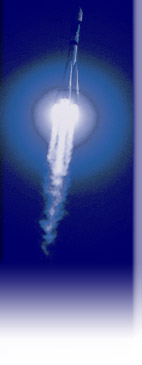Starsem's Soyuz is on the launch pad with its GIOVE-A payload!
December 27, 2005
All is ready for tomorrow morning's Starsem mission for the European Space Agency, as the Soyuz vehicle with its GIOVE-A payload are now poised for liftoff on launch pad no. 6 at Baikonur Cosmodrome in Kazakhstan.
 |
Starsem's Soyuz launcher is moved into position
on launch pad no. 6 at Baikonur Cosmodrome.
(Photo: © ESA). |
|
The completed Soyuz rolled out of its MIK 40 integration hall on a specially-designed rail car and was raised into its vertical launch position on the pad on December 25.
A full-scale launch rehearsal was performed December 26 to validate the readiness of Soyuz, its GIOVE-A payload and the ground station network that will track the mission. Successful completion of this review - which involved the Soyuz launch team, the European Space Agency, spacecraft manufacturer Surrey Satellite Technology and ground controllers - cleared the way for the final countdown's start at 11:00 p.m. tonight.
Liftoff is scheduled for tomorrow at 11:19 a.m. on a flight that will last a total of just over 3 hours 42 minutes, when the GIOVE-A satellite will be injected into its final 23,222-km. circular orbit following three burns of the Fregat upper stage.
This flight will be Starsem's 15th commercial flight, and is another demonstration of the company's ability to serve a full range of customers with missions that meet their specific requirements. It follows the November 9 Starsem mission that accurately placed Europe's Venus Express on an interplanetary trajectory, as well as the August 14 mission that put the Galaxy 14 telecommunications satellite into Earth orbit for U.S. operator PanAmSat.
 |
Soyuz is in its vertical position for launch.
The service platform (in foreground, left)
and umbilical mast (at right) will be raised
to meet the launcher. (Photo: © ESA). |
|
GIOVE-A is the first of two demonstrator satellites for Europe's new Galileo space-based navigation and positioning system. The second spacecraft - GIOVE-B - also will be launched by Starsem, with its liftoff scheduled in 2006. Eventually, the full Galileo constellation will consist of 30 satellites.
The GIOVE-A satellite to be carried on tomorrow's mission is a cube-shaped platform with a liftoff mass of 602 kg. Once in orbit, the spacecraft will perform several functions, including measuring the radiation environment in the Medium Earth Orbit (MEO) to used by Galileo satellites, testing the most critical Galileo technologies (including the on-board atomic clocks and signal generator), validating the novel features of Galileo's signal design, and securing access to the navigation system frequencies allocated by the International Telecommunications Union (ITU).
GIOVE-A's main payload elements are an L-band phased array antenna, the signal-generation units that will create two representative Galileo signals, two redundant compact rubidium atomic clocks, a pair of radiation monitoring systems to evaluate the Medium Earth Orbit, and a navigation receiver to experiment with autonomous localization in MEO.
For additional information on the successful Starsem GIOVE-A launch, review the previous updates, along with the post-mission press release and Starsem's official launch kit.
Press release:
- Read our press release about this successful Starsem mission.
Launch kit:
- Download the Starsem Starsem GIOVE-A launch kit for additional information on the mission and the Soyuz launch system. (2,344 Kb)







